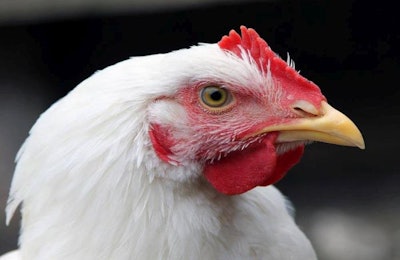
Two chicken proteins that may be involved in immune regulation of cancerous cells and viral infection have been characterized for the first time, opening up the possibility of new disease treatments.
Named Programmed cell death 1 (PD-1) and Programmed cell death ligand 1 (PD-L1), the protein pathways and their role in chronic viral infections are well-understood in humans, yet few studies have been conducted on their function in birds.
Now, however, scientists at the U.K.’s Pirbright Institute have demonstrated that the protein structures and interactions in chickens are highly similar to those in humans and other animals, where activation of these proteins is known to cause immune cell “exhaustion,” preventing the immune system from destroying infected cells.
In humans, PD-1 is found on the surface of immune cells, particularly T cells. Healthy cells have a PD-L1 receptor and, when bound to PD-1, the immune cell is inactivated, stopping it from destroying health tissue.
However, cells infected with viruses usually remove their DP-L1 receptors triggering T cells to attack and stop the spread of infection.
Yet some viruses are able to increase the number of PD-L1 receptors displayed by the infected cell, so preventing its destruction and allowing the virus to continue replicating. Chronic viral infections can lead to T cell exhaustion, where the T cells that should react against a specific virus become non-functional.
In a study published in Frontiers in Cellular and Infection Microbiology, the Pirbright team reveal that they have characterized the chicken PD-1 and PD-L1 (chPD-1 and chPD-L1) proteins, determining that their structure and interactions were similar to those in humans and other species, suggesting that they may have the same ability to suppress immune response.
Understanding immune response
The team also announced that it had generated the first specific antibodies against chPD-1 and chPD-L1, allowing closer examination of the interactions and effects of these proteins. They hope that their work will provide the basis for development of immunotherapy treatments that block the pathways, and which could revive immune cells enabling them to clear infection.
Demonstrating that this pathway exists in birds will help in understanding of how the poultry immune response deals with viral infection, and the research team is confident that the similarity of their newly characterized chPD-1 and chPD-L1 proteins to those in other species means that they are key in poultry immune system suppression.
Their next steps will be to investigate the role of chPD-1 and chPD-L1 pathways during infection and how viruses such as Marek’s disease virus manipulate the pathway to evade destruction, allowing the virus to remain latent in the infected cell and cause diseases such as cancer.
This could help in the creation of immunotherapies that revive T cells from their exhausted state and allow them to deal with infection. The Pirbright antibodies were unable to prevent interaction between chPD-1 and chPD-L1, but it is hope that further research will result in antibodies that block this pathway and can help to alleviate economically important poultry diseases.

















